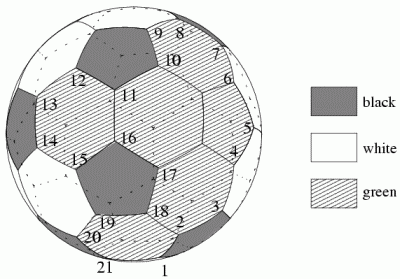| Submit | All submissions | Best solutions | Back to list |
FOOTBALL - Football |
Eric has a classic football that is made of 32 pieces of leather: 12 black pentagons and 20 white hexagons. Each pentagon adjoins 5 hexagons and each hexagon adjoins 3 pentagons and 3 hexagons. Eric drew a polygon (i.e. a closed line without intersections) along the edges of the pieces. The polygon divided the ball into two parts and Eric painted one of them green.

He is curious if given a description of the polygon you are able to compute the number of black, white and green pieces?
Task
Write a program that:
- reads the description of a polygon,
- computes the number of black, white and green pieces,
- writes the result.
Contest note: the first accepted solution will be awarded with the original football used for preparing the problem, signed by Eric, the author of the problem!
SPOJ note: the first accepted solution will be awarded some other sphere, without anybody's signatures, sent in PNG format to the author's email address [the offer is invalid, the sphere has already been presented to Robin Nittka, University of Ulm, Germany].
Input
The input begins with the integer t, the number of test cases. Then t test cases follow.
For each test case, the first line of the input contains one integer n being the number of vertices of the polygon. The second line of the input contains n integers a1, a2,..., an separated by single spaces. Integer ai (equal 1 or 2) is the number of green pieces adjoining the i-th vertex of the polygon. The side of the polygon connecting the n-th and the first vertex always lies between two hexagons.
Output
For each test case the first and only line of the output contains three integers b, w and g - the numbers of black, white and green pieces respectively.
Example
Sample input: 1 21 1 2 1 2 1 2 1 1 1 2 2 1 1 1 1 2 2 2 1 1 1 Sample output: 11 15 6
| Added by: | adrian |
| Date: | 2004-06-26 |
| Time limit: | 0.100s |
| Source limit: | 50000B |
| Memory limit: | 1536MB |
| Cluster: | Cube (Intel G860) |
| Languages: | All |
| Resource: | ACM Central European Programming Contest, Warsaw 2003 (E. Kopczynski) |


 RSS
RSS